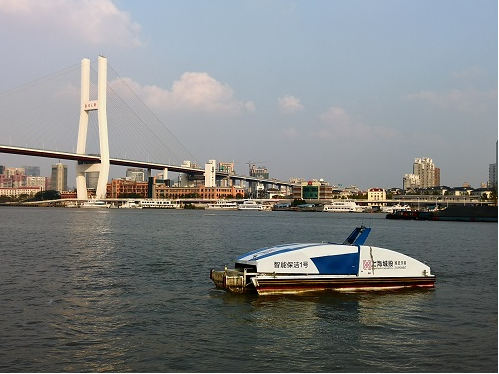If you see this small boat in the Huangpu River in Shanghai, don't be surprised. It's an intelligent cleaning autonomous surface vehicle that can clean up floating objects more than 3 cubic meters in a single operation.
The First China International Import Exposition was solemnly opened in Shanghai on November, 5. Intelligent cleaning autonomous surface vehicle --Intelligent Cleaning-1, developed by Hefei Institute of Intelligent Machines (IIM),Chinese Academy of Sciences (CAS) , appeared on the Huangpu River in Shanghai to ensure the cleaning of the Huangpu River during the Expo.
Intelligent Cleaning-1 is a highly intelligent unmanned autonomous surface vehicle. Its maximum displacement is more than 5 tons, and it can clean up floating objects more than 3 cubic meters in a single operation. Compared with inland small landscape lakes and urban rivers, the Huangpu River, as a class B navigation area, poses a great challenge to autonomous surface vehicle due to the tidal current, the bank effect, the optical mirror effect on the water surface and the waterfront boundary identification.
Although China has abundant water resources, the current situation of water ecological environment in China is not optimistic due to various reasons. For a long time, the cleaning and the monitoring of rivers and lakes have been conducted manually with low efficiency, long period and limited monitoring scope. The smelly contaminated water of rivers, lakes, reservoirs and landscape waters not only destroys biodiversity and ecological balance, but also potentially cause a serious human health hazard. Therefore, intelligent, automatic, safe and efficient surface cleaning equipment is urgently needed.
After years of research, researchers tackled technical problems and developed the first domestic autonomous surface vehicle capable of working in class B navigation area. It has three operating modes, including full autonomous cruise, remote driving and remote control. It is capable of water path optimization and autonomy avoidance in complex waters and narrow rivers. With new energy hybrid power technology, it has a new type of power drive and energy management system for ships. Aiming at the large tidal changes, the fast flow rate and the bank effect of the Huangpu River, the hull and propulsion system adopts synergetic optimization design and dynamic simulation to ensure the seaworthiness in the high-speed turbulent class B navigation area of autonomous surface vehicle.
The designed multiple redundant, multi-parameter and multi-degree-of-freedom adaptive control system for under-actuated systems makes the vehicle cruise in complicated water area with agility, reliability and robustness. The successful research and development of this product means manual cleaning for water will be replaced and the industrialization of unmanned cleaning ships will realize.
It is reported that there is no practical cleaning autonomous surface vehicle or similar product at home and abroad at present. Most of the existing surface cleaning unmanned ships are remote-controlled or using unmanned operation function of embedded systems, lacking of artificial intelligence software and hardware technology based on high-speed computing platform and artificial intelligence technology. They can only operate in waters with less wind and wave, such as landscape lake. Strictly speaking, they belong to primary unmanned ship due to the low-level intelligence and automation, anti-wind and wave level and weak cleaning operation function. They cannot achieve full autonomous intelligent cleaning operation. As a National Institute of intelligent machinery, the IIM actively meets the needs of the country. The intelligent cleaning autonomous surface vehicle, chaired by Dr. Yu Daoyang of professor Liu Jinhuai team, has achieved the autonomous operation ability of class B navigation area for the first time, and has realized industrialization, making.
According to the head of the research team of the institute, the existing technology can be extended to mobile monitoring of water quality, water ecological restoration and management, hydrogeological exploration and mapping, emergency rescue, security and protection of important waters, etc. 
Fig.1 Intelligent Cleaning-1
Contact:
Dr. Yu Daoyang,
Hefei Institute of Intelligent Machines Mechanics,Chinese Academy of Sciences
(http://www.iim.cas.cn/)
Hefei, Anhui 230031, China
Tel:0551-65592385
E-mail:ydy@iim.ac.cn
Image by YU Daoyang
